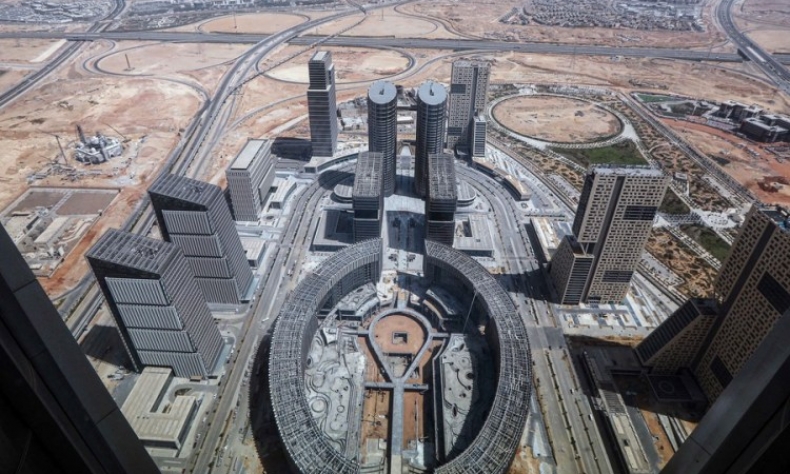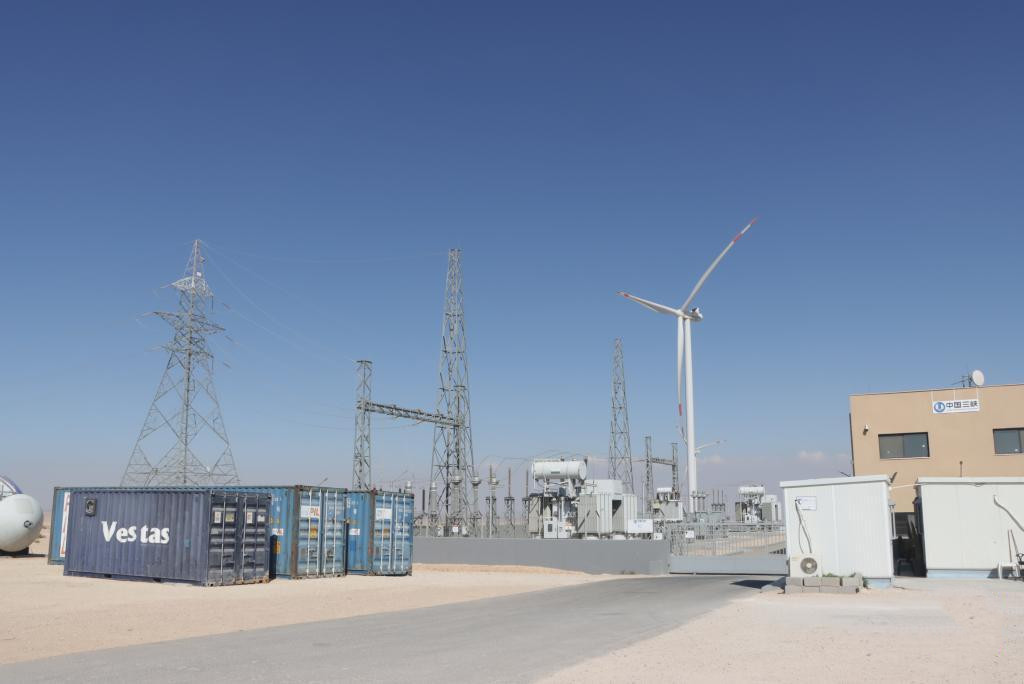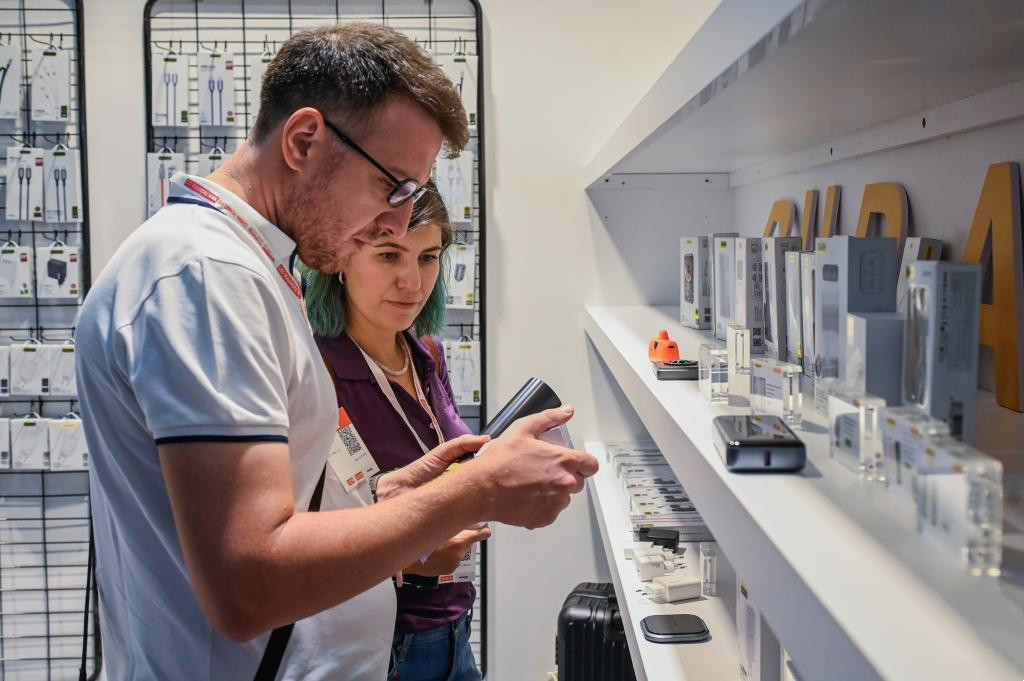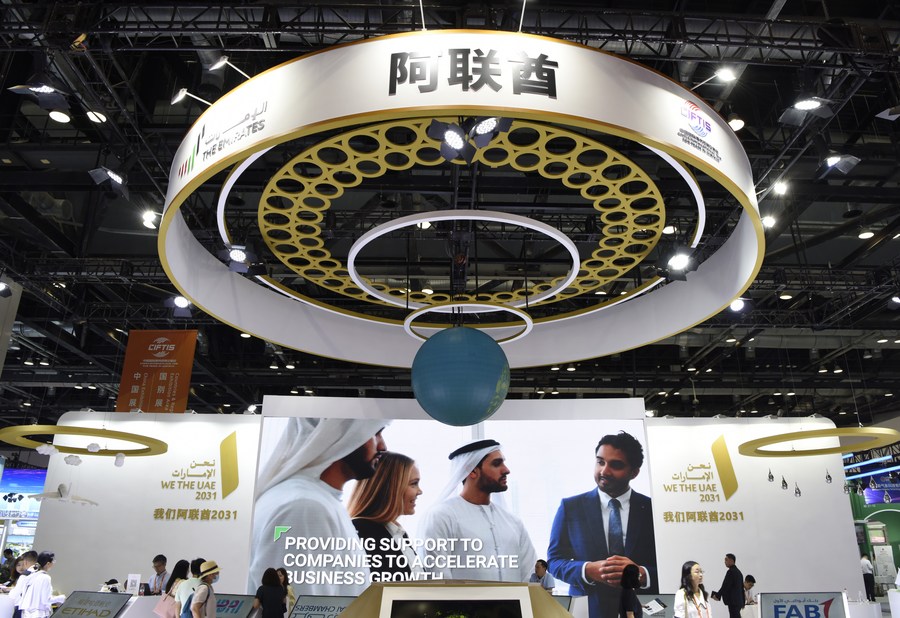China-Middle East Cooperation Thrives Under BRI

The BRI will serve as a shield protecting China and its partners in the Middle East from future turmoil in the turbulent international political situation, boost national and regional socioeconomic progress, and safeguard the space created for international peace and cooperation.
The Middle East is located at the junction of Europe, Asia, and Africa. It acts as a passageway between the Atlantic and the Indian Ocean and the Mediterranean Sea, the Red Sea, and the Arabian Sea. It is an important partner of China in building the Silk Road Economic Belt and the 21st Century Maritime Silk Road, or the Belt and Road Initiative (BRI). Since it was first proposed by China in 2013, the initiative has drawn strong support from Middle East countries, and China’s cooperation with the region has been expanding. The Middle East is now an important part of the BRI.
A fruitful decade
As the BRI takes roots in the Middle East, cooperation between China and regional countries is bearing fruit.
The cooperation mechanism has been improved So far, 20 out of the 22 countries in the Middle East have signed cooperation agreements with China. Some of them have established coordination mechanisms for cooperation under the BRI. Such mechanisms include the China-Saudi Arabia High-Level Joint Committee, the China-Egypt Cooperation Mechanism for Production Capacity, the China-Arab States Technology Transfer Center, and the China-Morocco Committee on Energy Cooperation. These mechanisms are the outcomes of earlier cooperation initiatives, and will advance the partnership to new heights in the coming years.
The BRI has also breathed new life into conventional multilateral mechanisms, such as the China-Arab States Cooperation Forum (CASCF). Addressing the sixth ministerial conference of the CASCF in 2014, President Xi Jinping called for China and Arab states to join hands in building the BRI. He said this cooperation should be centered on the energy sector, underpinned by infrastructure construction and trade and investment facilitation, and spearheaded by breakthroughs in the hi-tech sectors of nuclear energy, space and satellite, and new energy.
In 2019, China and the League of Arab States signed the Declaration of Action on China-Arab States Cooperation under the Belt and Road Initiative, the first of its kind between China and a regional organization.
The cooperation between China and countries in the Middle East under the BRI taps into the former’s strengths in production capacity and caters to the latter’s development needs, especially for increasing economic diversification.

A number of key projects have been launched for this purpose. They include the China-Saudi Arabia (Jizan) Industrial Park, the China-Iran Auto Industry Park, the China-Egypt Suez Economic and Trade Cooperation Zone, the China-UAE Industrial Capacity Cooperation Demonstration Zone, the Khalifa Port in the United Arab Emirates (UAE), the Chabahar Port in Iran, the Dammam Port in Saudi Arabia, the Kumport Terminal in Türkiye, the Al Ahdab oilfield in Iraq, the Yanbu refinery, solar plants in Qatar, the Hassyan power complex in Dubai of UAE, the central business district at the new administrative capital of Egypt, the south-north expressway in Algeria, the Lusail Stadium (the main venue for the 2022 FIFA World Cup) in Qatar, and large hydro power facilities in Sudan.
These projects showcase China’s engineering strengths, boost economic and social progress in the host countries, and bear witness to the pragmatic cooperation between China and the Middle East that is bringing tangible benefits to all participants.
The BRI is inclusive and keeps abreast of the times. This is why China and the Middle East have been able to continuously open up new fronts in their cooperation under the initiative on the basis of policy coordination, infrastructure connectivity, unimpeded trade, financial integration, and closer people-to-people ties. Since 2014, China has proposed to build a Space Silk Road, Green Silk Road, Silk Road of Health, and Digital Silk Road, eyeing closer cooperation in the fields of aerospace technology, low-carbon and clean energy, public health, digital economy, artificial intelligence, nano technology, and quantum computing. These calls for cooperation have been warmly received by countries in the Middle East.
With an urgent demand for energy transition, the world’s leading oil producers in Middle East have entered into cooperation with China in the fields of solar, wind, nuclear, and hydrogen power. Progress has also been made in other areas: China, Saudi Arabia, Egypt, the UAE and other countries in the Middle East jointly launched the Belt and Road Digital Economy International Cooperation Initiative; China’s Huawei participated in the development of smart cities in Saudi Arabia and the UAE; China cooperated with the UAE, Saudi Arabia, and Egypt in space and satellite navigation technologies; Chinese companies teamed up with businesses in the UAE and Morocco for joint production of COVID-19 vaccines.

A solid foundation
The fruitful cooperation between China and countries in the Middle East under the BRI can be attributed to the fact that the two sides embrace similar development philosophies, follow similar development paths, and have common interests.
China and countries in the Middle East are all on the path of ensuring livelihood and peace by pursuing greater development. This lays the strategic foundation for their BRI cooperation.
The past decade has seen changes and turbulences across the international community. In the Middle East, countries are still suffering from the aftermaths of the Arab Spring beginning in 2010 as indicated by continuous regional conflicts, lingering economic woes, frequent public protests, and resurging extremist sentiments. The bitter lessons learned from the past and the pressing needs of the present led countries in the region to the understanding that the fundamental cause of turmoil in the Middle East is insufficient development, and that development is the only solution to national and regional problems.
With this understanding, Saudi Arabia, the UAE, Qatar, Kuwait, Egypt, and Türkiye have formulated their respective mid- and long-term development plans. They are exploring new paths of independent development, and paying more attention to sustainable development and regional cooperation. This approach falls in line with China’s proposition of seeking peaceful common development through cooperation, and aligns with the BRI’s goal of pursuing common prosperity. This, therefore, creates the precondition and strategic foundation for broad cooperation between China and the Middle East under the BRI.
In their cooperation, both China and the Middle East emphasize mutual benefits, complementarity of advantages, and shared interests. This has built up a strong driving force for their cooperation.
China and countries in the Middle East complement each other in terms of economic structure and resource endowments. China is the largest trading partner of the Middle East, exporting mechanical and electrical products, textiles, home appliances, and toys, among other commodities to the region. Chinese products provide people in the region with more options and greater ease in all aspects of life. Meanwhile, the Middle East is China’s most important energy supplier. The BRI has not only enhanced the traditional economic and trade relations between the two sides, but also expanded their mutually beneficial cooperation in the sectors of industrial investment, digital economy, finance, and technology.

The BRI is compatible with the long-term development strategies of countries in the Middle East, and helps reinforce them. In 2015, China and Türkiye signed a memorandum of understanding on aligning the BRI with the Middle Corridor initiative, and established an intergovernmental cooperation committee and a working group to handle relevant issues. In 2022, China and Saudi Arabia signed an implementation plan for synergizing the BRI and the Vision 2030 plan, aiming to advance bilateral cooperation across the board, especially in the fields of infrastructure, energy, trade, investment, culture, and people-to-people exchanges. Progress is also being made in aligning the BRI with Egypt’s Sustainable Development Strategy: Egypt Vision 2030, Iran’s 20-Year National Vision, and other national development plans. Top-level planning and alignment between national development plans facilitate pragmatic cooperation, and benefit both China and countries in the Middle East in addition to creating a driving force for deepening cooperation between the two sides.
In their relations, China and the Middle East place stress upon dialogue on equal footing, mutual respect, and inclusiveness, which are safeguards for long-term cooperation under the BRI. Historically, the Middle East has been an arena of great power rivalry. In modern times, the U.K., the U.S., France, and the former Soviet Union were all deeply involved in the region, competing for resources and influence by forming alliances, interfering militarily, and ruling through proxies. These acts harmed the well-being of local people, and are the primary external reason for recurring unrest in the region. Having had enough of foreign interference and meddling, countries in the Middle East are wary of and averse to any unequal regional order and relationships.
As an emerging developing country, China brings no such historical baggage when handling its relations with the Middle East. It is committed to building partnerships based on equity and goodwill, respects and supports the right of other countries in choosing their own development paths according to their respective conditions, and calls for harmonious co-existence between all civilizations. China’s Middle East policy is based on the principle of seeking no proxies, no sphere of influence, and no intention to fill power vacuums. Instead, China dedicates itself to promoting peace through dialogue, and urges countries to team up under the BRI for win-win cooperation.
In carrying out specific projects, China holds equal dialogue with countries in the Middle East, respects their respective conditions, interests and concerns, follows market rules and international practices, and attaches no political strings. This approach has created a new model of opening-up and international cooperation in the Middle East. The model accommodates the stances and demands of all parties involved. It has also increased mutual trust, which is critical for the BRI’s sustained development in the region.

Bright prospects
Over recent years, the trend of promoting national development, international cooperation, and region-wide dialogue has been gaining momentum across the Middle East. The Abraham Accords signed by Israel and four Arab states augured improvement in their relations. Gulf states ended a four-year split, and resumed dialogue and cooperation amongst themselves. Türkiye embarked upon a new round of “charm diplomacy” to improve ties with its neighbors. In April this year, archrivals Saudi Arabia and Iran restored diplomatic ties, a move followed by a thaw in Iran’s relations with other members of the Arab world. This has opened up new opportunities for local countries’ domestic economic growth and regional cooperation.
Under such circumstances, the consensus between China and the Middle East to deepen BRI cooperation has been reinforced, their shared interests, a foundation for this cooperation – expanded, the technical conditions for cooperation improved, and social environment grown more conducive. The BRI presents broad prospects for enabling a virtuous cycle of development-peace-security.
Amid intensified competition among major powers and restructuring of the international order, developing countries constitute an unstoppable rising force. Some established powers nevertheless choose to fall back into the outdated mentality of camp confrontation. They clamor for economic decoupling, separation of supply chains, and “small yards with high fences,” all in an attempt to obstruct globalization and drag the world back into division and isolation.
Developing countries, including those in the Middle East, don’t want to get involved in major power competition, and they wouldn’t let it impede their development and governance. Instead, they hope to balance their relations with major countries to open a new path of strategic independence. This need tallies with China’s proposal of advancing globalization and building a global community of a shared future for humanity. As an initiative of openness, inclusiveness, mutual benefit, and connectivity, the BRI proposed by China presents a new option for countries in the Middle East to promote future development. Their cooperation with China under the BRI is a good example of South-South cooperation and a model of developing countries enhancing solidarity, mutual assistance, development, and self-reliance.
With its cooperation mechanisms and the achievements that have been made, the BRI will serve as a shield protecting China and its partners in the Middle East from future turmoil in the turbulent international political situation, boost national and regional socioeconomic progress, and safeguard the prospects and space created for international peace and cooperation.
Li Yanan is an associate researcher with the Institute of Middle East Studies, China Institutes of Contemporary International Relations.
 Facebook
Facebook
 Twitter
Twitter
 Linkedin
Linkedin
 Google +
Google +










